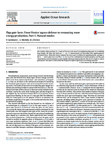Flap gate farm: From Venice lagoon defense to resonating wave energy production. Part 1: Natural modes
| dc.contributor.author | Sammarco, P | |
| dc.contributor.author | Michele, Simone | |
| dc.contributor.author | d’Errico, M | |
| dc.date.accessioned | 2021-08-09T14:29:13Z | |
| dc.date.available | 2021-08-09T14:29:13Z | |
| dc.date.issued | 2013-10 | |
| dc.identifier.issn | 0141-1187 | |
| dc.identifier.issn | 1879-1549 | |
| dc.identifier.uri | http://hdl.handle.net/10026.1/17507 | |
| dc.description.abstract |
We consider a flap-gate farm, i.e. a series of P arrays, each made by Q neighboring flap gates, in an infinitely long channel. We show that there are P × (Q - 1) natural modes and determine their eigenfrequencies and modal forms. When the distance between the arrays goes to infinity the eigenfrequencies converge to the Q - 1 values given by Li and Mei [14]. For an ad-hoc combination of channel geometry and flap gate characteristics, modal excitation can give significantly larger response than for the case of a single or a sparse gate system. This aspect is relevant for the design of an optimal gate farm wave energy converter. © 2013 Elsevier Ltd. | |
| dc.format.extent | 206-213 | |
| dc.language | en | |
| dc.language.iso | en | |
| dc.publisher | Elsevier BV | |
| dc.rights | Attribution 4.0 International | |
| dc.rights | Attribution 4.0 International | |
| dc.rights | Attribution 4.0 International | |
| dc.rights.uri | http://creativecommons.org/licenses/by/4.0/ | |
| dc.rights.uri | http://creativecommons.org/licenses/by/4.0/ | |
| dc.rights.uri | http://creativecommons.org/licenses/by/4.0/ | |
| dc.subject | Flap gate energy | |
| dc.subject | Wave-body interaction | |
| dc.subject | Eigenmodes | |
| dc.title | Flap gate farm: From Venice lagoon defense to resonating wave energy production. Part 1: Natural modes | |
| dc.type | journal-article | |
| dc.type | Journal Article | |
| plymouth.author-url | https://www.webofscience.com/api/gateway?GWVersion=2&SrcApp=PARTNER_APP&SrcAuth=LinksAMR&KeyUT=WOS:000329682600021&DestLinkType=FullRecord&DestApp=ALL_WOS&UsrCustomerID=11bb513d99f797142bcfeffcc58ea008 | |
| plymouth.volume | 43 | |
| plymouth.publication-status | Published | |
| plymouth.journal | Applied Ocean Research | |
| dc.identifier.doi | 10.1016/j.apor.2013.10.001 | |
| plymouth.organisational-group | /Plymouth | |
| plymouth.organisational-group | /Plymouth/Faculty of Science and Engineering | |
| plymouth.organisational-group | /Plymouth/Faculty of Science and Engineering/School of Engineering, Computing and Mathematics | |
| plymouth.organisational-group | /Plymouth/Users by role | |
| plymouth.organisational-group | /Plymouth/Users by role/Academics | |
| dc.identifier.eissn | 1879-1549 | |
| dc.rights.embargoperiod | Not known | |
| rioxxterms.versionofrecord | 10.1016/j.apor.2013.10.001 | |
| rioxxterms.licenseref.uri | http://creativecommons.org/licenses/by/4.0/ | |
| rioxxterms.type | Journal Article/Review |



